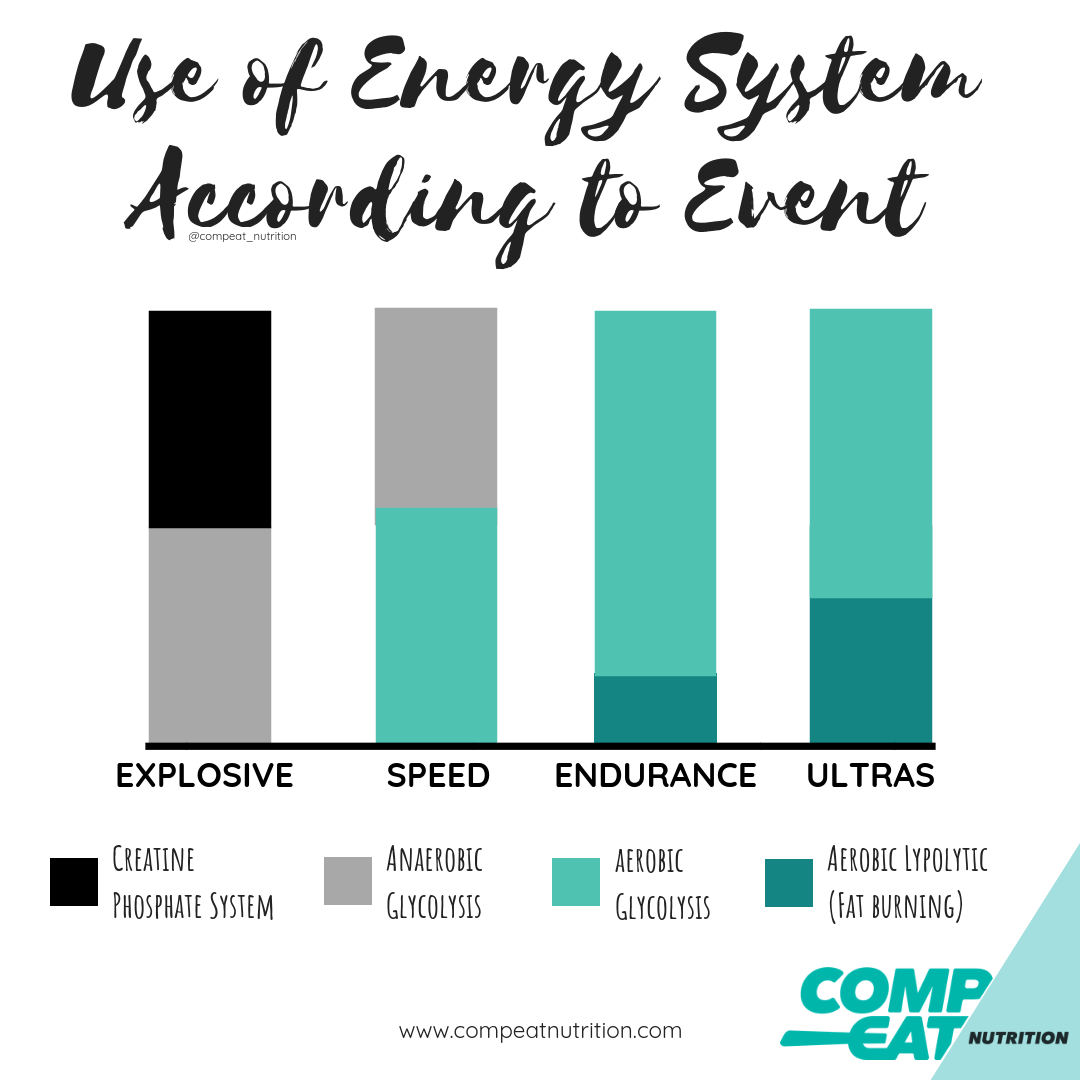Event Fuelling (Part two): Energy Systems in Sport
Welcome back to event fuelling (Part Two)! Now that we’re in the thick of some exciting competitions, I thought it would be an appropriate time to revisit – but first, let’s recap what we learned in Part One.
Energy is sourced from a tiny molecule called ATP. This molecule is involved in processes in the body that require energy, including muscle contraction. Once your body has used up its ATP, it can easily make more – however, the system it uses to restore its supply is dependent on the energy demand. In other words, the more intense the exercise, the quicker the body will need to work to replenish its stores.
There are 3 main systems we have already discussed include:
- The creatine phosphate system which is useful in short bursts of max intensity efforts.
- Anaerobic glycolysis is the system that shifts into gear once the creatine phosphate system is depleted. This is useful for exercises lasting between 5-30 seconds and repeated efforts within a short period of time.
- For efforts beyond the 30-60 second mark, we see the aerobic glycolysis system taking control (“Air”-obic because we need oxygen for this system to work). This system takes longer to work but generates a lot more energy than the other two.
How this translates to sporting events
Every sporting event is different and has its own set of energy requirements. However, they can be grouped into broad terms according to their activity pattern. Understanding which energy systems each sport uses will inform what nutrition intervention is required to meet the demands of the sport.
Explosive Events
Explosive events involve a single burst or explosive action, are of short duration (typically less than 10 seconds) and use high loads. They require the athlete to move an object (either their own body or a projectile) as far or as quickly as possible. These events include sprinting, jumping events, throwing events and Olympic Weightlifting.
In these sports, very little fuel is used up during the event as the energy comes from the quickly replenishing creatine phosphate system. However, there may still be a need to fuel appropriately during training sessions as repeating the same exercise over and over can shift the athlete into different energy systems (see intermittent events below for more info).
Supplements may also be extremely beneficial in this space, so this will be explored further in following posts.
Speed Events
Speed events involve the maintenance of a high intensity activity for a slightly longer duration (15-120 seconds). Due to this, the overall load placed on the athletes is reduced. These events include middle distance running, rowing, track cycling, swimming or any other event with a pre-determined path or routine lasting less than two minutes.
During these events, we shift to using about 50% aerobic and 50% anaerobic. The longer the event (e.g. around that 120 sec mark), the more input from the aerobic system is needed. This means the athlete must use more oxygen, which makes the lungs work overtime.
In these events, we tend to burn through moderate amounts of energy, which needs to be considered for refuelling post event – especially if you are needing to repeat that effort within the same day!
Endurance Events
During these events, we shift almost exclusively to the aerobic energy system. These events involve repetitive actions (running, cycling, rowing) maintained over a much longer duration. Marathon, triathlon and road cycling are great examples of endurance events.
In these events, we tend to burn carbohydrates in the blood and muscle at a rapid rate. This means that the athlete is at risk of being carbohydrate deplete if they do not follow an appropriate pre and during-event nutrition plan. The result of switching fuel sources will feel like that all too familiar ‘hitting the wall’ or ‘bonking’.
You can absolutely improve your efficiency in fuel usage with concepts of fat adaptation, however at race pace, your need to utilise (and replace!) carbohydrates will be essential to performance.
Ultra-Endurance Events
A natural extension of the endurance event is the ultra-endurance event. During these races, athletes will begin to shift to burning fats through the aerobic system which will provide them with even more energy in the long term. This is due to fats being an extremely efficient and almost endless fuel source, and also due to the lower intensity of ultra events. Once again though, it will still be essential to train the body for this, practice race nutrition pre-event and still fuel adequately pre- and during- the event to avoid the dreaded bonk.

Intermittent Events
Intermittent events are inconsistent when it comes to intensity or duration in competition. An athlete may be sprinting one minute and walking the next – so there is no way to precisely predict the activity profile of the event. However, what we do know is that the athlete will tend to maintain a high intensity throughout and will make use of all three energy systems mentioned so far. These events include team sports, combat sports and racquet sports.
Cross training circuits such as CrossFit events or F45 generally fall into this domain unless they involve maximal lifts/sprints (see explosive events above) or longer “chipper” style workouts (see endurance events above). Athletes are often asked to perform multiple workouts in a single day which are extremely taxing on the body’s energy supplies. Restoring lost energy stores is a priority in between these events.
These events are heavily glycogen depleting meaning that most of your muscle carbohydrate stores will be used up. Therefore, excluding carbohydrates when trying to compete is likely to have an adverse effect on performance rather than anything positive. If you are wanting to limit carbohydrate intake or dip your toes into keto, it is important you time this at the right point of your season or training so that your health, recovery and performance aren’t affected.
So What’s Next?
As we continue to explore energy systems and event fuelling, consider what type of fuelling is best for your chosen activity or event. There is no one right way to eat, so it is more about adapting the intake that works best for you to match your fuelling demands and recovery goals.
If you feel as though your event nutrition is not helping you perform at your best, have a chat with one of our dietitians to see what we can improve.
In the meantime, don’t stop here! To understand more about pre and post-event fuelling jump onto our knowledge hub. We have new videos on event fuelling every week, so come and join our crew to check them out!
Stay tuned for Part Three coming up soon!

ALICIA EDGE HEAD SPORTS DIETITIAN
Alicia is the head Advanced Sports Dietitian at Compeat Nutrition. She is also a mum and triathlete, so advice extends beyond the basics and is instead focused on providing effective and achievable nutrition for both training and racing.